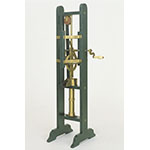The most distinctive feature of this hydraulic pump is the handle system for operating the piston. The arrangement was intended to transform the rotary motion of the handle into the to-and-fro linear motion of the piston more efficiently. It was invented by Jeremiah Sisson, in 1758, to improve the performance of conventional suction pumps for raising liquids. The connecting rod attached to the barrel carries a brass fitting with two perpendicular slits forming a cross; it is reinforced with a brass ring. A cursor, connected to the handle that operates the machine, moves back and forth through the horizontal slit. When the piston rises, the water is sucked though a valve in the base of the pump. When the piston falls, the valve remains shut, while a second valve at the center of the piston opens, letting the water flow over it. In the next upward stroke, the water raised by the piston fills a crown placed on the top of the pump and spills out of a beak. This demonstration model represents the type of pump long used in many houses to draw water. Provenance: Lorraine collections.










